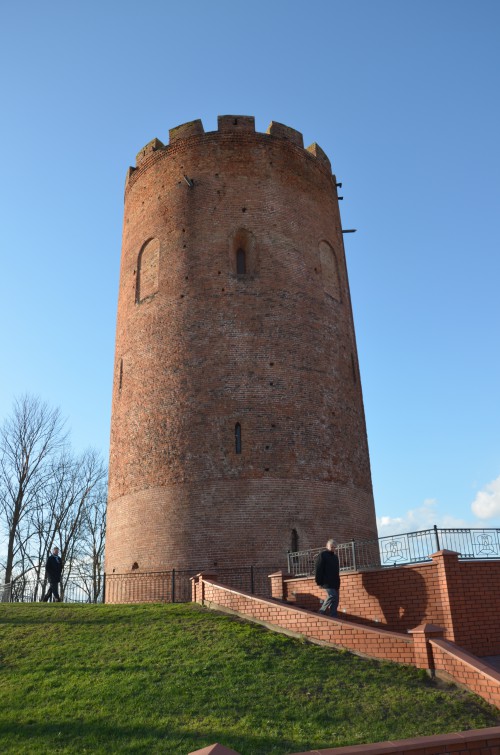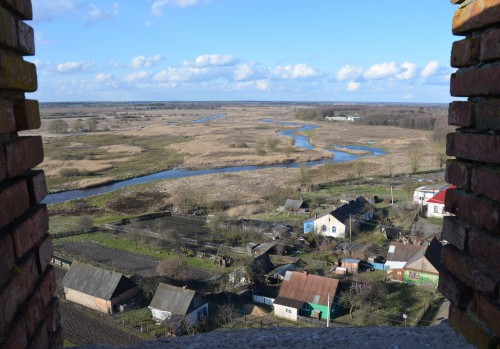30th April 2015
Local History – Краеведение
Local history – Soviet heritage…
I recently visited some places in Belarus for the first time. The most striking was the tower of Kamianets, one of several strongholds built by the rulers of the Volhynia principality in the 13th century to protect their northern border. It is one of the few medieval remains in Belarus. It is 30 metres high, but the main entrance was up wooden steps 15 metres above the ground.
Kamianets is a small town near the Belovezhskaya Pushcha, one of the few remaining pockets of the ancient forests of Europe. These places are quite unique for Europe, let alone Belarus, and it was fascinating to meet and hear local people talk about their particular histories.
This is “local history”, the history of particular places and the communities that lived in them. Histories of states and countries tend to focus on major political events. Local history is more about the cultural and social aspects of a locality. There tends to be fewer records about what went on in a particular area, compared to the vast archives that states accrue. So local history museums often display artefacts found in the locality, or details of the legends and tales of the area.
I didn’t realise that the interest was quite strong in the Soviet Union. Local history study was Краеведение – or the “management of territory” (my translation). Study of local history was apparently common in Soviet schools. Perhaps there is a Belarusian revival of this earlier interest.
…or a Victorian invention?
If there is a date when the study of local history in Britain could be said to have started, it is probably 1899, when Archibald Constable & Co, a British publisher, began the “Victoria County History”. The aim was to produce a history of each of England’s 39 historic counties, in honour of Queen Victoria. This would be done by many writers chronicling the distinctive landscape and landmarks, old buildings and other aspects of each settlement and drawing on the ancient records available.
The series was a private venture, but perhaps overly ambitious, as it soon run out of money. Its first main editor, William Page, found a sponsor, so that the first volumes could be published and the series gradually extended. Page only secured its future when he persuaded the Institute of Historical Research, of the University of London, to take responsibility for the project in 1933.
Much of the material was actually researched and written up by amateur historians, who volunteered to work on the project out of personal interest. This is still very much a feature of local history study – it is usually conducted by local people.
One of the most influential professional historians conducting research into local history was W. G. Hoskins, who studied how human activity affected the evolution of the English landscape. This included agricultural systems, patterns and features of human settlements, and the effect of industrialisation. He also was the first head of a Centre for English Local History, set up at Leicester University.
Our appetite for the history of local places is strong. We have the British Association for Local History, which is a charity that brings together many different groups dedicated to study local history. There is even a “Local History Magazine” and its online website.
What lies hidden under car parks and in archives
Perhaps the most extraordinary recent example of local history research was the discovery of the body of King Richard III under a car park in Leicester by a consortium, including representatives of the University. He was the last Plantagenet king of England, killed at the Battle of Bosworth Field in 1485. He was infamous through his portrayal in Shakespeare’s play as an evil, power grabbing hunchback, who murdered his nephews to become king.
The University played a central role in not only organising the search, but then in authenticating whether the remains were those of the king. The University hosts the laboratories where Professor Alec Jeffreys developed techniques for DNA fingerprinting and DNA profiling, now used to determine paternity. They were able to compare DNA found in the remains with that of his nearest surviving relative – a mere 18 generations younger. On 26 March this year, Richard’s remains were re-interred in Leicester Cathedral.
Richard III’s case is perhaps the most eye-catching. But why is there such interest in local history? There seem to be several factors that accentuate the interest in Britain.
The long continuity of British history has allowed for the collection of extensive local archives. These provide lots of material for anyone interested in a particular place. The earliest historical document was the Doomsday Book, a survey of much of England and Wales completed way back in 1086 by order of the King, William I, the Norman Conqueror of Anglo-Saxon England. This remarkable undertaking was in fact an effort by William to find out how much each landholder had in land and livestock, to work out what tax they should pay.
Local history: laying a foundation for national identity
As I noted previously, Britain and especially England in the south east, is a densely populated land compared to Belarus. And as I set out in explaining the attraction of gardening, we like our own space, and we have spread out and cultivated or built on much of our land. The result is that as well as a long history, our country is packed with rich detail on places, buildings, and all sorts of sites to discover.
Then there is local community activism. Britain is full of many sorts of social organisations, and local history groups are just another facet of an active and vibrant civil society. Finding out about their area, and seeking to preserve the local heritage can bring a community together.
An interest in local history is very useful in attracting tourism. The re-interment of Richard III’s remains drew a lot of people to Leicester, and made national and international news because it was such an unusual event.
Perhaps the most obvious point is that people want to make sense of where they live. This is probably related to the theme of national identity that I wrote about last year. Nations comprise of many communities, and may be less relevant to our lives than our own local community and places familiar to us.
But it may be that people want to record where they were living. The Victoria County History began at the end of a period of rapid urbanisation, and the writers probably wanted to conserve memories of local places before they disappeared.
I suspect the motives of many local historians are quite mixed. But finding out about our surroundings, and wanting to know who came before us and what they did, is very human. We all want to know and understand where we come from.
Henry of Bolingbroke (Henry IV of England) in 1392 and Count Bedford in 1394 paid their visits to this country.
‘We all want to know and understand where we come from.” Right you are, Bruce!